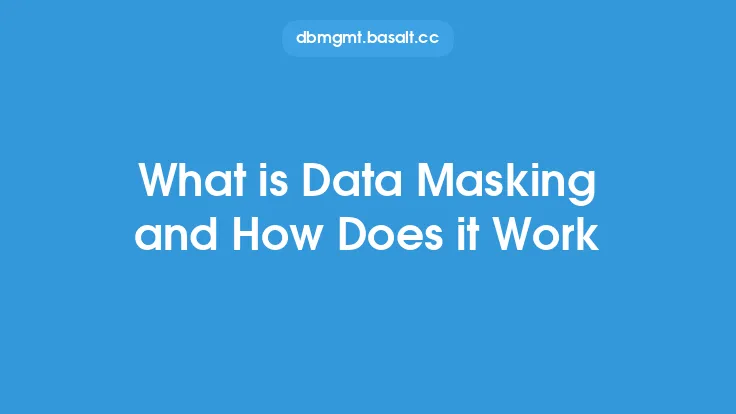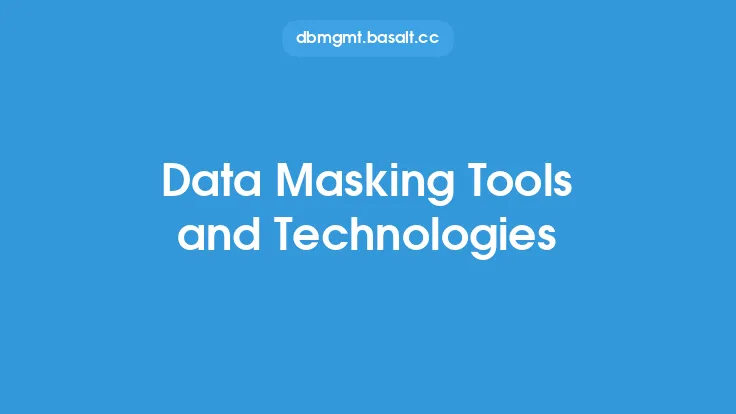Data masking is a crucial aspect of database security that involves hiding sensitive information from unauthorized users. There are several techniques used to mask data, each with its own strengths and weaknesses. In this article, we will delve into the different types of data masking techniques, exploring their characteristics, advantages, and use cases.
Introduction to Data Masking Techniques
Data masking techniques are designed to protect sensitive data by making it unreadable or unusable to unauthorized users. These techniques can be applied to various types of data, including personal identifiable information (PII), financial data, and confidential business information. The primary goal of data masking is to prevent data breaches and ensure compliance with regulatory requirements. There are several data masking techniques, including static data masking, dynamic data masking, and data encryption.
Static Data Masking
Static data masking involves permanently masking data in a database or data storage system. This technique creates a copy of the original data, masks the sensitive information, and then stores the masked data in a separate database or data storage system. Static data masking is typically used for non-production environments, such as development, testing, and training. The advantages of static data masking include improved data security, reduced risk of data breaches, and compliance with regulatory requirements. However, static data masking can be time-consuming and resource-intensive, especially for large datasets.
Dynamic Data Masking
Dynamic data masking, on the other hand, involves masking data in real-time, without permanently altering the original data. This technique uses policies and rules to determine what data to mask and when to mask it. Dynamic data masking is typically used for production environments, where data needs to be accessed and used by authorized users. The advantages of dynamic data masking include improved data security, reduced risk of data breaches, and real-time protection of sensitive data. However, dynamic data masking can impact system performance and may require significant resources to implement and manage.
Data Encryption
Data encryption is a technique that involves converting plaintext data into unreadable ciphertext. This technique uses algorithms and keys to encrypt and decrypt data, making it inaccessible to unauthorized users. Data encryption can be used to protect data at rest and in transit. The advantages of data encryption include improved data security, reduced risk of data breaches, and compliance with regulatory requirements. However, data encryption can impact system performance and may require significant resources to implement and manage.
Data Redaction
Data redaction involves removing or masking sensitive information from documents, images, and other files. This technique is typically used to protect confidential information, such as financial data, personal identifiable information, and confidential business information. Data redaction can be used to comply with regulatory requirements, such as the General Data Protection Regulation (GDPR) and the Health Insurance Portability and Accountability Act (HIPAA).
Data Tokenization
Data tokenization involves replacing sensitive data with tokens or placeholders. This technique is typically used to protect payment card information, personal identifiable information, and other sensitive data. Data tokenization can be used to comply with regulatory requirements, such as the Payment Card Industry Data Security Standard (PCI DSS).
Data Anonymization
Data anonymization involves removing or masking personally identifiable information from data sets. This technique is typically used to protect personal data, such as names, addresses, and phone numbers. Data anonymization can be used to comply with regulatory requirements, such as the GDPR and HIPAA.
Data Perturbation
Data perturbation involves modifying data to make it less sensitive or less identifiable. This technique is typically used to protect confidential information, such as financial data and business information. Data perturbation can be used to comply with regulatory requirements, such as the GDPR and HIPAA.
Data Masking for Big Data and Cloud Environments
Data masking for big data and cloud environments involves protecting sensitive data in large-scale data storage systems and cloud-based infrastructure. This technique requires specialized tools and technologies, such as Hadoop and Spark, to mask and protect sensitive data. Data masking for big data and cloud environments can be used to comply with regulatory requirements, such as the GDPR and HIPAA.
Choosing the Right Data Masking Technique
Choosing the right data masking technique depends on several factors, including the type of data, the level of sensitivity, and the regulatory requirements. Organizations should consider the strengths and weaknesses of each technique, as well as the resources required to implement and manage them. Additionally, organizations should consider the impact of data masking on system performance and user experience.
Conclusion
In conclusion, data masking is a critical aspect of database security that involves hiding sensitive information from unauthorized users. There are several data masking techniques, including static data masking, dynamic data masking, data encryption, data redaction, data tokenization, data anonymization, and data perturbation. Each technique has its own strengths and weaknesses, and choosing the right technique depends on several factors, including the type of data, the level of sensitivity, and the regulatory requirements. By understanding the different types of data masking techniques, organizations can protect their sensitive data and comply with regulatory requirements.





